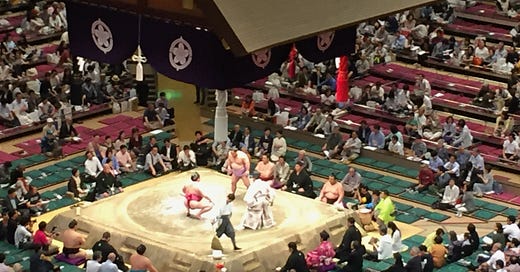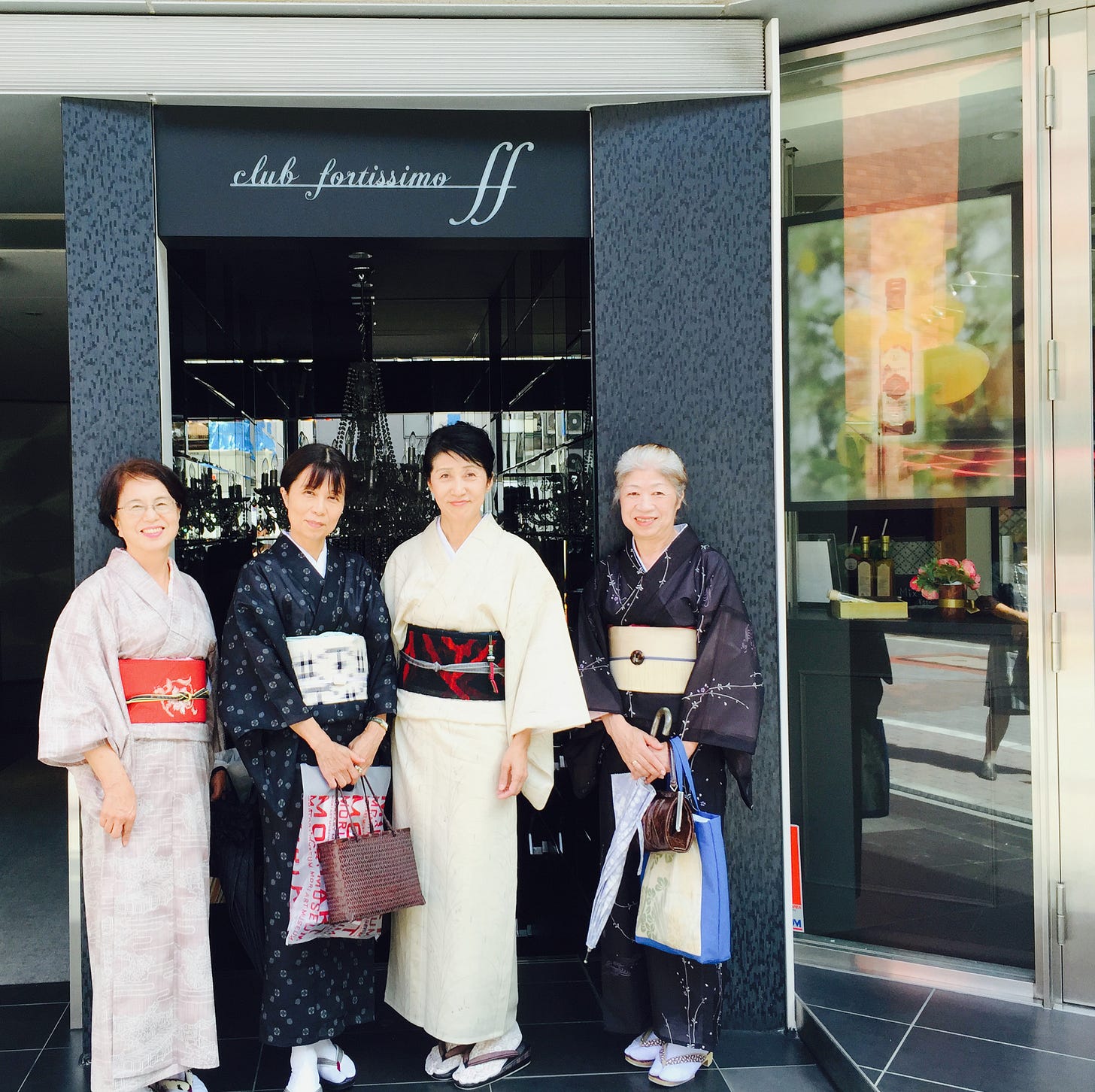Why I'd rather be a Japanese woman than a Japanese man
Hola Jigsawers,
Hope all is well. My boys are finally back in school today after a loooong summer break, so I am writing this post in luxurious solitude. Being a mother while being a writer has been a process of constant negotiation from the beginning – a process I detailed in my 2016 book, Babies and Bylines. As a writer, my gender has shaped my observations, my circumstances and perhaps my inclinations.
In the past I have written about why I’d rather be a woman in China than in India. In this post, I’m going to make the case for why I’d rather be a Japanese woman than a Japanese man.
*******
The image
Globally, Japan suffers from a negative image when it comes to the status of women. In the World Economic Forum’s annual Global Gender Gap Report 2020 Japan placed at 121, the lowest among advanced economies.
The stereotype of a land of misogynist men and meek, long-suffering women is an entrenched one. Even Indians often tutted and shook their heads sadly when they learned that I’d lived in Tokyo. “Terrible situation for women there, “they’d say. “So sad.’
The reality
This felt absurd. To begin with women in Japan were safe. They occupied public spaces with confidence. They dressed as they liked. They drank what they liked. They tended to be more sexually liberated than the global norm.
Even the idea that Japanese women stayed at home, unwelcome by the workforce needs to be tempered. In fact, women in Japan exceeded the rate of labour force participation of women in the United States. In 2016, Japan’s prime-age female labour force participation rate was at 76.3 percent, compared to a U.S. rate of 74.3 percent.
The problem
The problem was that greater participation in the work force did not automatically lead to greater empowerment. Far more Japanese women worked in part-time and non-regular jobs than men. Women also occupied a much smaller share of executive positions compared with other countries. In Japan, only 12.9 percent of management jobs in 2016 were held by women, according to the Japan Institute for Labour Policy and Training. This compared to 43.8 percent in the U.S. and 32.9 percent in France.
There was furthermore an egregious absence of women in politics. Women accounted for just 10.2 percent of the 463 seats in the Lower House.
That the patriarchy has deep-roots in Japan was indisputable. Its tentacles are spread widely from the world of Sumo wrestling to the country’s universities. Two “incidents” from my time in Japan stand out.
Sumo scandal
In April 2018, the Mayor of Maizuru, a city in south-central Japan, had a stroke and collapsed while making a speech inside the ring at a local sumo tournament. Two women, one of whom was a nurse, rushed to his assistance. But instead of appreciating their efforts, an agitated referee asked them to immediately leave the ring, because they were female.
Sumo is deeply intertwined with Shinto religious rites and women are not welcome in the wrestling ring, being deemed impure because of menstruation and childbirth, an aversion that is part of many Hindu, Buddhist and Shinto practices.
A sumo tournament in Tokyo Pic credit: Pallavi Aiyar
The Japan Sumo Association (JSA) eventually issued an apology and judged the referee’s response as inappropriate given the life-threatening nature of the situation. However, its general attitude to women and the sport was unchanged.
For an Indian, the exclusion of women on religious grounds, however spurious was somewhat par for course. But the revelation, only a few months after the sumo incident that a leading medical school in Tokyo had been systematically rigging its entrance exams against women applicants for more than a decade was shocking even by Japan’s unedifying standards of sexism.
Medical malpractice
In August 2018, Tokyo Medical University admitted to having regularly subtracted points from the test scores of every woman test taker. Officials even worked from a manual that laid out precisely how the scores were to be manipulated to keep the number of women students at the university down to around 30% of the total. The rationale: too many women doctors would cause problems down the line, including staffing shortages when they stopped work or took time off to raise children.
The reasons that women in Japan struggled in the workplace were manifold. Discrimination dogged them from their early years. As the Medical University case demonstrated, they had to work harder and prove themselves more able than their male competition. Many of these challenges were universal, stemming from the persistence of patriarchal norms that viewed the ‘home’ as the proper place for a woman.
Culture of overwork
But there was one obstacle that was particularly acute in Japan: a general habit of overwork that penalized flexibility and rewarded time spent at the workplace. An almost sacred reverence for hard work was built into the company culture in Japan. For employees, stoic endurance was considered a virtue, while leaving the office before one’s superiors was frowned upon. When someone did go home they took their leave with the phrase, “osaki ni shitsureishimasu,” which translates as “apologies for leaving before you.”
It bordered on the impossible to balance the demands of raising children with work norms like these. A friend, a former employee of Mitsubishi who now stays at home looking after her two boys, told me that when she went to her boss to explain the fact that the long hours at work were proving impossible to reconcile with the needs of her children, he’d nodded sympathetically and said he understood. “Yes, it is too difficult, I agree. I think you have to quit,” he’d said. She did.
There was more to the practice of staying long hours at the offices than either the demands of the boss or even virtue signaling. Employees often had nowhere else to go. With cramped homes and long commutes as the norm, offices served as quiet spaces or ‘dens’ for many people.
My boys being bratty at our friend’s home
I began to understand this behavior only after visiting a Japanese friend’s home for the first time.
Julio had a dear Japanese friend, whom I will call Suzuki, from his days as an undergraduate at university in England. After moving to Tokyo, we received an invitation to visit Suzuki’s home which was an hour’s train commute from central Tokyo.
Suzuki himself made this journey twice a day since his office was located downtown. Suzuki’s building complex turned out to be a depressingly good example of 1960s-style brutalist architecture. It was an enormous box-like cement structure with long, sparse corridors interspersed with hovel-sized apartments. We were welcomed by him, his delightful wife and two lively children into what was essentially a studio apartment, comprising a single, medium-sized room, a bathroom and a tiny kitchen.
“Is this it?” whispered one of my brats loudly, while I tried to shush him. “Where are the beds?” asked the other as Julio stamped on his foot in warning. We sat down on the floor (as was Japanese custom) around a table laden with strawberries and other fruit. I assumed the beds were futon mattresses hidden away in cupboards and brought out at night to sleep on, after the table was moved out of the way. The room was stuffed full of toys, books and other sundry items.
My boys had gotten over their first reaction to Suzuki’s home within minutes, bonding with the other children and cracking up at shared jokes. But Julio and I took a little longer to digest the fact that his friend who had been educated in the UK and had a good job at a world-renowned company lived in what felt to us like straitened circumstances.
Suzuki’s wife told me that her husband stayed out drinking with colleagues most nights and only returned late, after the rest of the family had gone to bed. But she confessed that it worked best like this. On evenings that Yuji returned home early he only got in the way of the children’s evening study and bedtime routines. Over the years we became very close to the couple and even holidayed together in the summer. As he opened up, Suzuki told me he felt awkward going home early on weekday evenings. He had no space to wind down and felt like an intruder in his own home.
The larger problem
Rather than just a lack of women in the work force, the larger problem in Japan, it seemed to me, was its punishing work culture that made any semblance of work-life balance impossible for men or women. A culture of overwork certainly kept women out of the economy and did little to encourage Japan’s woefully low birth rate.
As a result, many Japanese were choosing not to have children or even to get married. And overwork did not make employees more productive, only more stressed out. What was needed was a systemic overhaul of Japan’s work practices. Working less, but smarter would benefit men, women, and families.
Better a woman than a salaryman in Japan
Under current circumstances I would rather be the average Japanese woman than a typical salary man. A life of long commutes, suffering insufferable bosses, bowing and scraping to clients and being forced to ingest large quantities of alcohol most nights was not appealing. Women might have led lives of boredom and unrealized potential, but they could meet a friend for lunch, cuddle their children at night and read a good novel before bed.
Group of lunching women in Ginza. Pic credit: Pallavi Aiyar
****************
Please do share this piece with friends on social media, so we can grow this community, and post any comments/feedback in the section below.
Also, so sorry to sound like a bore, but I can’t avoid repeating my weekly appeal to readers to consider switching to a paid subscription. Its only 5 USD a month and will help this experiment independent media output greatly.
Hasta luego,
xoxo





